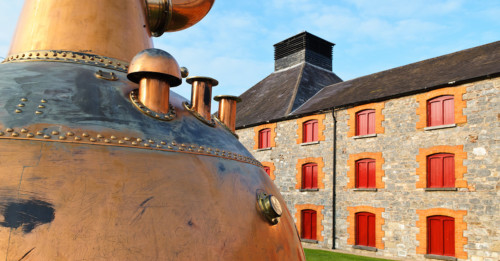Irish Whiskey Essential Info
- Color: Pale straw to light amber
- Region: Ireland
- ABV: 40%
- Aged: Must be aged a minimum of 3 years in wood casks (new or previously used)
- Made from: Barley, malted and unmalted (can also be made with other added grain)
- Commercial Examples: Jameson, Redbreast, Tullamore Dew, Powers, Tyrconnell
- Popular Cocktails: Irish Coffee, Behind the Times, The Emerald, The Copywriter, The Irish Cocktail
The Irish probably got their first, but by now Scotch whisky is arguably more famous (and not just for deleting that “e”). But that doesn’t mean Irish whiskey isn’t worth exploring, especially since it’s enjoying a much-deserved comeback. See, Ireland was once teeming with distilleries. And while, thanks to some historical hiccups, only four distilleries remain—New Midleton, Cooley, and Kilbeggan are all relatively young, while Bushmills was founded in 1608 (yup)—Irish whiskey is on the rise.
But what makes whiskey Irish? Legally, it’s just whiskey born and raised in Ireland, distilled to no higher than 94.8% ABV and wood-aged for a minimum of three years. Clearly there’s more than a little wiggle room here, which distilleries are using to their advantage to create interesting, globally competitive whiskies. For one, Irish whiskey is typically blended, but that doesn’t mean distilleries aren’t experimenting with single malt. Irish whiskey is also generally unpeated, but again, exceptions are possible (as with Cooley’s Connemara). And while many Irish whiskies are triple-distilled—theoretically one reason Irish whiskey is smoother and lighter than Scotch—again that rule isn’t hard and fast. As for how it’d distilled, Irish whiskey used to be made exclusively in pot stills, but today they can be either pot-distilled or a mixture of column- and pot-distilled spirits.
A very specific Irish whiskey term to note: pot still or single pot still, which means the whiskey is pot-distilled mixture of both malted and unmalted, or green, barley, which imparts a certain (delicious) oiliness and spice. Another difference of note, Unlike Scotch, Irish whiskies are allowed to add enzymes to assist in preparing starches for fermentation. But when it comes to aging, as with scotch, Irish whiskies can mature in a variety of vessels—Madeira casks, Sherry casks, Bourbon barrels, rum barrels, etc.—and finished barley whiskies can also be blended with grain whiskies to make the final product.
Given that ability to mix and match and experiment (with peat, grain, finishing casks, etc.), Irish whiskey is defying most old school stereotypes. Not that Irish whiskies aren’t often still often smooth or light, they’re just also, increasingly, a lot more, showcasing anything from heather, herbs, and grass to light fruit, honey, almond, toffee, butterscotch, clove, apples, and golden raisins (and counting).
